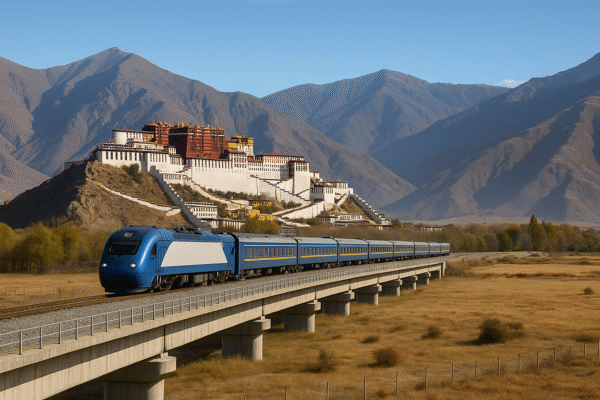Tibet Eyes a Bright Future as Construction Launches on Strategic Xinjiang–Tibet Railway
Tibet is on the verge of a transformative chapter in its history. In 2025, construction is set to begin on the long-anticipated Xinjiang–Tibet Railway, an ambitious project that will connect Hotan in Xinjiang to Shigatse and Lhasa in the Tibet Autonomous Region. This monumental undertaking promises to revolutionize transport, strengthen economic ties, and open new pathways for investment and tourism.
Reviving Long-Held Ambitions with Real Momentum
For decades, the idea of a railway linking the far-flung regions of northwestern and southwestern China has been a strategic vision. Now, with official approval and a substantial budget allocation of approximately USD 13.2 billion, that vision is moving toward reality. The proposed route, stretching around 2,000 kilometers, will traverse some of the most challenging terrains on Earth, including high-altitude plateaus, permafrost zones, and mountain ranges such as the Kunlun and Karakoram.
The railway will become a cornerstone of China’s broader plan to create a 5,000-kilometer plateau railway network centered on Lhasa by 2035. This network aims to interlink Tibet with Xinjiang, Qinghai, Sichuan, and Yunnan, creating a more cohesive economic and transport framework across western China.
A Turning Point for Tibet’s Economy
The Xinjiang–Tibet Railway is expected to deliver significant economic benefits:
- Lower logistics costs & market expansion: Transporting goods into and out of Tibet has long been costly due to its remote location. The new line will streamline freight movement, enabling local products—from agricultural goods to handicrafts—to reach wider domestic and international markets more efficiently.
- Boosted tourism potential: With easier access, Tibet’s breathtaking landscapes and cultural treasures will attract greater numbers of visitors. The resulting growth in tourism will bolster hospitality, dining, transportation, and related sectors.
- Job creation and investment: The construction phase will generate thousands of jobs, while the completed railway will sustain employment in operations, maintenance, tourism, and trade. Improved connectivity is expected to attract both domestic and foreign investors in sectors like hospitality, manufacturing, and real estate.
- Regional integration: Strengthening Tibet’s links with the national economy will enhance its resilience to supply chain disruptions and allow it to play a more active role in China’s broader economic growth.
Complementing Tibet’s Expanding Rail Network
The Xinjiang–Tibet Railway will be Tibet’s third major rail line, joining:
- The Qinghai–Tibet Railway, operational since 2006, which was the first to link Tibet to the rest of China by rail.
- The Sichuan–Tibet Railway, currently under construction, which will provide a faster route from Chengdu to Lhasa.
- Additional planned lines such as the Yunnan–Tibet Railway, which will eventually extend the network further south.
Together, these projects will expand Tibet’s total railway mileage to over 5,000 kilometers by 2035, including more than 1,000 kilometers of double-track lines.
Engineering Feats in the Making
Constructing the Xinjiang–Tibet Railway will require overcoming extraordinary technical challenges. Engineers must contend with extreme temperatures that can drop to minus 40 degrees Celsius, low oxygen conditions, and unstable permafrost. The route will involve extensive tunneling through rugged mountain terrain and the construction of bridges capable of withstanding seismic activity.
These engineering achievements will not only demonstrate China’s technical capabilities but also set new standards for high-altitude railway construction worldwide.
Tourism Set to Flourish
Tourism is expected to be one of the biggest beneficiaries of the new railway. Tibet’s unique combination of natural wonders, such as Mount Everest and Namtso Lake, and cultural landmarks like the Potala Palace, has always attracted travelers. However, limited accessibility has kept visitor numbers lower than their potential.
With the new rail link, domestic tourists will be able to travel more conveniently, while international visitors will find Tibet more accessible through connections from major Chinese cities. This influx will stimulate demand for hotels, restaurants, guided tours, and local handicrafts, creating a ripple effect of economic benefits across the region.
Tibet’s Path Forward: Integration, Growth, Sustainability
The Xinjiang–Tibet Railway is more than a transportation project; it is a catalyst for social, economic, and cultural transformation. By improving access, reducing costs, and fostering investment, the railway will lay the groundwork for sustainable development in Tibet.
As construction begins in late 2025, this landmark project will signal the start of a new era—one where Tibet is more connected, more prosperous, and better positioned to share its beauty and heritage with the world. Over the next decade, the railway will reshape the region’s economic landscape, elevate its tourism industry, and strengthen its place within China’s western development strategy.
For more travel news like this, keep reading Global Travel Wire
















